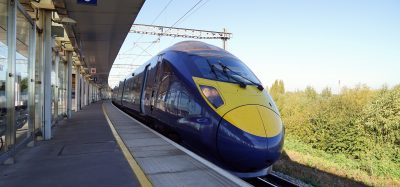Developments in railway tracks
Posted: 28 December 2008 | | No comments yet
One of the most important developments in the last decade was the large scale application of slab track. This is in particular the case for high-speed tracks. In countries like The Netherlands, with very soft soil conditions, classical high-speed tracks could only be realised without massive soil improvements via grouting and deep mixing. This is […]
One of the most important developments in the last decade was the large scale application of slab track. This is in particular the case for high-speed tracks. In countries like The Netherlands, with very soft soil conditions, classical high-speed tracks could only be realised without massive soil improvements via grouting and deep mixing.
This is due to the fact that the Rayleigh waves propagate with a speed in the same order as the train speed. Rayleigh waves travel a little slower than shear waves1.
Therefore, The Netherlands decided to build slab track on a piled foundation, in fact a low viaduct. For the slab track solution, various designs were investigated. Initially the embedded rail was the preferred solution. For this purpose a 3km long section was built near Best in The Netherlands.
The main advantages of this structure are: top down construction, continuous support of the rail, so less susceptibility to corrugation, little heating due to solar radiation and less noise and vibration.
Although the preferred solution was embedded rail, the banks and lenders decided otherwise. As there was no experience at 300 km/h they considered the risks too high and decided that a proven system should be chosen. This has resulted in adopting the Rheda 2000 system from Germany.
Presently there is a tendency to apply more slab track, especially for high-speed lines. The pioneers were the Japanese with their Shinkansen slab track. Recently the high-speed line in Taiwan was completed on which the Shinkansen track was applied.
The latest development on high-speed is of course magnetic levitation. A salient application is the Transrapid in Shanghai, a 35km link connecting the city with the airport. In Europe, attempts have been made for many years to get this system off the ground, without much success. In my opinion this is the system of the future with a number of significant advantages:
- Operational speed 450km/h
- Contactless, so no friction, wear and high dynamic loads
- No vibration nuisance
- Limited noise exposure, so hardly costs for noise mitigating measures like noise screens
- Fast acceleration and deceleration, in which the braking energy can be restored in the system
- Safe, as trains in one block can only travel in the same direction
TU Delft has carried out a large number of analyses for the high-speed project in The Netherlands, but also for various other projects in Europe and Asia. The dynamic analyses were carried out with a special purpose program called DARTS (Dynamic Analysis of Railway Track Systems), in which complete train sets can run over a track system at any speed. Only the vertical dynamics are considered. Typical response values such as wheel rail forces, rail displacements and car body accelerations can be produced.
For 3D analyses, TU Delft is using various finite element packages like ANSYS, ABACUS and for vehicle dynamics ADAMS Rail and SIMPACK.
At TU Delft, a systematic methodology was developed to analyse the dynamic behaviour of track structures. This was investigated and systemised via the project DYNATRACK2. Both classical and slab track structures were considered, with special emphasis to the embedded rail structure. A method was developed to assess a structure on the basis of the dynamic response, both via modeling and experimentally via an instrumented excitation hammer, while simultaneously recording rail accelerations.
Within the project silent train traffic, a subproject was carried out called silent track. The objective was to develop a slab track which produces 5 dB(A) less noise than the classical ballasted track. This has resulted in the SA 42 embedded rail solution, a 42 kg/m rail cast into Corkelast, which is fit for carrying 22.5 tons axle loads. This innovative solution is silent, slender, has a reduced height, and is substantially cheaper than the standard embedded rail structure due to less steel and less polyurethane.
In the last decade, research at TU Delft was especially focusing on contact mechanics, associated with the wheel rail forces. The most important aspects were: optimisation of the wheel rail interface and wheel rail dynamics.
The problems were initially focused on so-called headchecks. The first large European research project dated from the early 90s and was conducted by ORE. Now, many years later, it becomes clear how the mechanism for the development of headchecks operate. The bogies, and especially the transfer of the driving forces to the track, play an important role. The contact geometry of the wheel rail interface also has a significant influence, whereby small deviations have a great influence in both a positive and negative sense. By modifying the rail geometry through grinding, the contact points can be shifted and this could mitigate the problems.
The ORE study also addressed problems associated with squats. These problems presently manifest themselves on a large scale in the ProRail network. Squats are vertical indentations due to plastic deformation and seem to be associated with local imperfections in the rail material and on the other hand with overloading due to imperfections in the rail head geometry.
Track rerecording has always played an important role in the quality control of the permanent way. Track recording cars primarily focus on long waves in the track, in the order of wavelengths from 10-150m. An omission in these systems is that they insufficiently account for the short waves, roughly speaking from 10m and shorter. These are responsible for the dynamic forces exerted on the track and consequently for track deterioration. From track defect statistics it is well known that track failures and a rapid deterioration of the track geometry are usually caused by poor weld geometry. But also the earlier mentioned RCF defects increasingly provide contributions to these problems.
In the 1980s, I performed in a lot of research into the influence of weld geometry on the life cycle of track3. More recently the development of theory has got a major boost due to the Ph.D. study of Michael Steenbergen4, 5, 6. Within this research, TU Delft has developed new weld geometry standards for ProRail based on confining the dynamic wheel rail force. The first derivative, or inclination, of the longitudinal rail geometry appears to be the decisive factor. For welds in high-speed operation, the norm is 1 milliradian, or 1:1000. A norm without a measuring instrument is of course a paper tiger! Therefore an electronic straightedge was developed, the so-called RAILPROF. With this instrument, the vertical and horizontal weld geometry are measured simultaneously and analysed.
The RAILPROF is controlled by a PDA, communicating via bluetooth. The PDA is also responsible for storage of the measuring data and assessment of measurements. On the PDA screen, the welder can immediately see where the weld geometry deviates from the norm and thus where has to be ground.
All information per weld which consists of the weld registration information requested by ProRail, the RAILPROF measuring file and the GPS coordinates are all transmitted wirelessly to a central server via GPRS.
The problem with weld geometry measurement, especially for high-speed lines, is the measuring accuracy, which should be in the order of 0.1 mrad, ie 10 % of the norm. The accuracy of versines is in the order of 5 micron. This dictates very strict requirements to the sensors and could only be achieved via contactless techniques. The principle applied in the RAILPROF is based on eddy current, which makes the measurements more or less independent of rust, dirt and moisture.
Infraspeed has tested all the welds on the HSL-South according to the new standards referred to previously. For high-speed lines in particular, this is the only way to measure and control weld geometry sufficiently and accurately.
Moreover, one of the great advantages of these new standards is that no distinction is made anymore between positive and negative welds. According to the old standards, based on versines, negative welds were not allowed. It is absolutely necessary that the new standards are put on the international agenda, for instance CEN.
References
- Esveld, C.: Modern Railway Track, MRT-Productions, Zaltbommel, 2001.
- de Man, A.P.: Dynatrack – a survey of dynamic railway properties and their quality, PhD Thesis, Delft University of Technology, 2002.
- Esveld, C.: STRAIT, Innovative straightening of rail welds, Rail International/Schienen der Welt, July 1983.
- Esveld, C and M.J.M.M. Steenbergen: ‘Force-based assessment of rail welds’, In Proc. of 7th World Congress on Railway Research, Montreal, Canada, 4-8 June 2006.
- Steenbergen, M.J.M.M., Esveld, C. Rail weld geometry and assessment concepts. Proc. IMechE, Part F: Journal of Rail and Rapid Transit, 2006, 220 (F3), 257-271.
- Steenbergen, M.J.M.M., Esveld, C. Relation between the geometry of rail welds and the dynamic wheel-rail response: numerical simulations for measured welds, Proc. IMechE, Part F, Journal of Rail and Rapid Transit, 2006, 220 (F4), 409-424.
About the author
Prof. Coenraad Esveld
Prof.dr.ir. Coenraad Esveld is a leading recognised figure within the railway engineering industry. Educated at Delft University and the Technical University of Warsaw, Professor Esveld holds many advisory and chairman positions for various committees. Professor Esveld is currently Professor of Railway Engineering at TU Delft.






